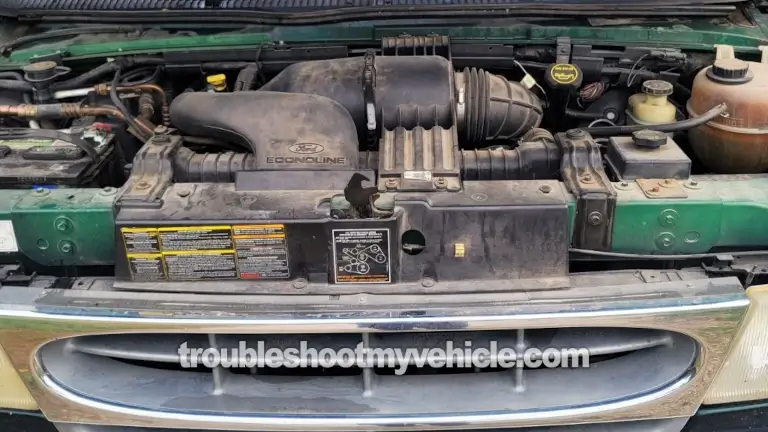
Doing an engine compression test on the V8 engine in your Ford E-Series van is quite the challenge, mainly because removing the spark plugs is quite the job (been there, done that).
I'm not mentioning this to discourage you, though. An engine compression test is crucial for checking what's going on inside your engine.
In this tutorial, I'll show you how to perform the compression test and, importantly, how to read its results. This way, you'll determine if there are any cylinders causing trouble, like misfires or preventing the engine from starting.
Contents of this tutorial:
APPLIES TO: This tutorial applies to the following vehicles:
- V8 Ford E150: 1997, 1998, 1999, 2000, 2001, 2002, 2003, 2004, 2005, 2006, 2007.
- V8 Ford E250: 1997, 1998, 1999, 2000, 2001, 2002, 2003, 2004, 2005, 2006, 2007.
- V8 Ford E350: 1997, 1998, 1999, 2000, 2001, 2002, 2003, 2004, 2005, 2006, 2007.
Symptoms Of Low Or No Engine Cylinder Compression
In my experience, problems with engine compression tend to lead to one of these headaches:
- Cylinder Misfire: The engine starts and runs, but it shakes a lot when it's idling. In tech terms, this is known as rough idle or a misfire condition.
- Engine No-Start: You'll hear the engine cranking, but it won’t actually start.
When an engine compression problem is allowing the engine to start, you're going to see one or more of the following symptoms:
- Check Engine Light: The check engine light will be illuminated on your van's instrument panel.
- Misfire trouble codes: You many see one or more of the following:
- P0300: Random Cylinder Misfire.
- P0301: Cylinder #1 Misfire.
- P0302: Cylinder #2 Misfire.
- P0303: Cylinder #3 Misfire.
- P0304: Cylinder #4 Misfire.
- P0305: Cylinder #5 Misfire.
- P0306: Cylinder #6 Misfire.
- P0307: Cylinder #7 Misfire.
- P0308: Cylinder #8 Misfire.
- Engine Performance Problems: You many see one or more of the following:
- Engine is not as peppy as it was once.
- Rough idle that goes away as soon as you accelerate the engine.
- Bad gas mileage: The engine has to work harder if one or more cylinders aren't functioning properly.
- Blue smoke: Having blue smoke coming out of the tailpipe is a classic sign of engine compression problems.
- A heavier exhaust smell: A heavier-than-normal exhaust smell coming out of the tailpipe is due to one or more cylinders not being able to properly compress and combust the air/fuel mixture within them.
Which Compression Tester Should I Buy?
There are lot of engine compression testers to choose from and many places to buy them. I'm gonna' make two recommendations to you:
1) Which one to buy: The engine compression tester that I have always used is the Actron CP7827 Compression Tester Kit. My only complaint about this engine compression tester is that it does not come with a case to store it in.
TEST 1: Finding The Dead Cylinders

To nail the most accurate result on your compression test, I strongly suggest checking all eight cylinders.
If you've already pinpointed a 'dead' cylinder and just wanna focus on that, no problem; no need to check them all. But you'll still need to compare it with one or two others to see if the 'dead' one's compression is more than 15% lower than the highest compression you get from the others.
After you get those numbers and if any cylinders are showing lower compression than the rest, we'll figure out (in the next part of this tutorial) whether they're really causing trouble or not.
If you don't have a compression tester, you can borrow one or buy one from your local auto part store. If you'd like to save a few bucks, check out my recommendations here: Which Compression Tester Should I Buy?
IMPORTANT: If the engine has been running for any length of time, let it cool down completely before removing the spark plugs.
OK, these are the test steps:
- 1
Disable the ignition system by removing fuse #8 from the dash fuse panel.
This will prevent the ignition coils from sparking during the test. - 2
Remove the spark plugs. Remember, the engine can not be hot!
When removing the spark plugs, be careful not to drop any on the floor, or you run the risk of having the spark plug's porcelain insulator crack and then you'll have a misfire on your hands. - 3
Thread the engine compression gauge into the spark plug hole for the number 1 engine cylinder.
NOTE: Hand tighten the compression gauge only! Do not use any type of tool to get it tight. - 4
Have your helper crank the engine till the needle on the compression gauge stops climbing.
- 5
Record the value at which the needle stopped and the number of the engine cylinder on a piece of paper.
- 6
Release the pressure on the gauge and repeat step 4 and 5 one more time.
- 7
Repeat test steps 3 - 5 on the remaining cylinders.
Let's examine your test results:
CASE 1: One or more cylinders had a much lower compression value than the others. Up to a certain range, this could be normal.
To further interpret these test results go to: Interpreting The Compression Test Results.
CASE 2: All eight cylinders had almost no compression or 0 PSI compression. This low or zero compression on all cylinders will cause the engine to not start.
Having a compression value close to 0 PSI or 0 PSI is usually due one of the following problems:
- A busted timing chain.
- Blown head gasket.
- The engine threw a rod.
CASE 3: The compression value of all cylinders was similar and above 120 PSI. This test result lets you know that an engine compression problem is not behind the misfire condition and/or engine no-start problem you're troubleshooting.



